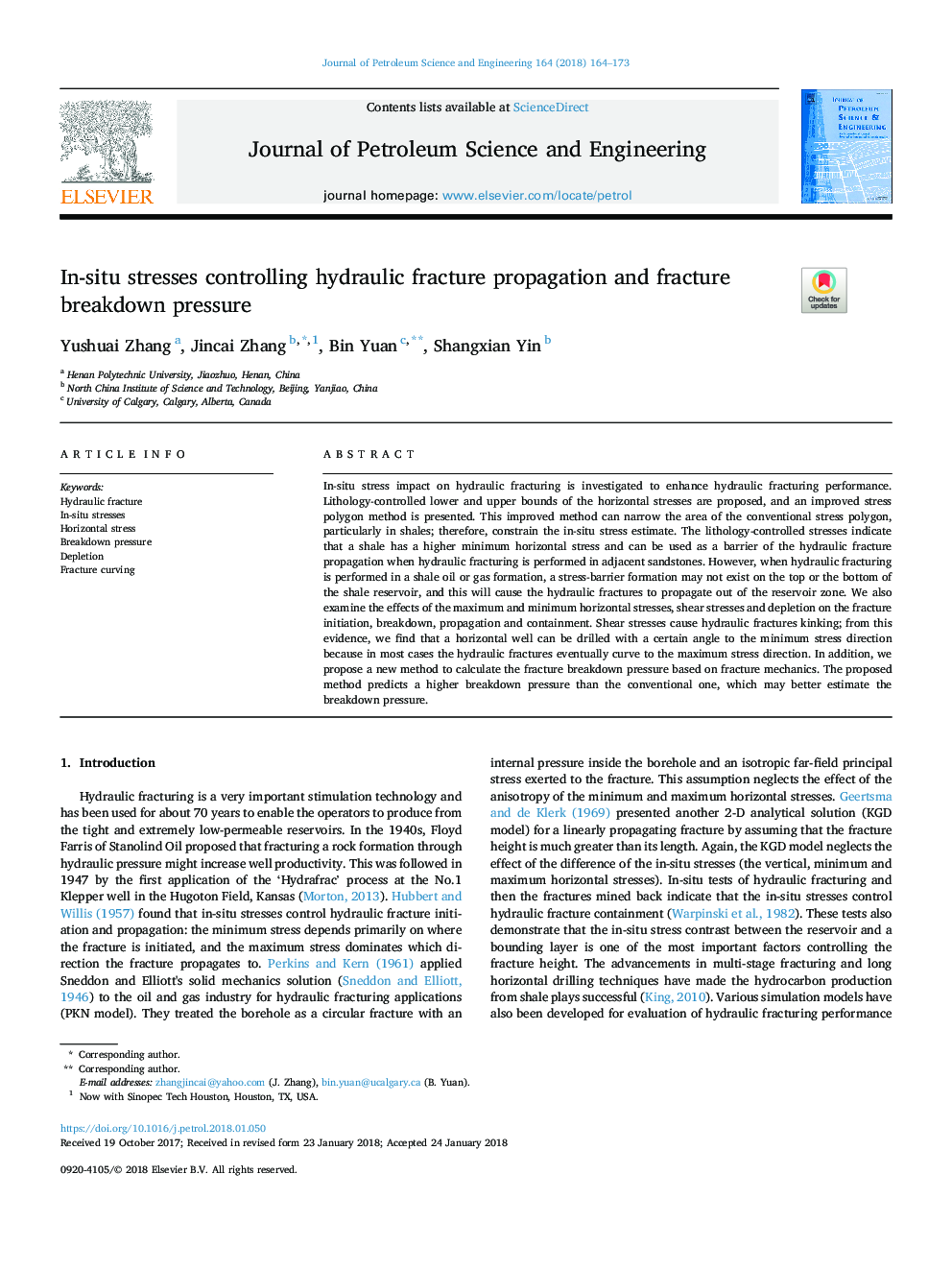| کد مقاله | کد نشریه | سال انتشار | مقاله انگلیسی | نسخه تمام متن |
|---|---|---|---|---|
| 8125296 | 1522777 | 2018 | 10 صفحه PDF | دانلود رایگان |
عنوان انگلیسی مقاله ISI
In-situ stresses controlling hydraulic fracture propagation and fracture breakdown pressure
ترجمه فارسی عنوان
استرس های در محل کنترل جهش شکست شکستگی و شکست شکستگی فشار
دانلود مقاله + سفارش ترجمه
دانلود مقاله ISI انگلیسی
رایگان برای ایرانیان
کلمات کلیدی
شکستگی هیدرولیکی، استرس در محل، استرس افقی فشار فشاری، تخلیه، انحناء شکستگی،
ترجمه چکیده
اثر استرس در محل بر روی شکستگی هیدرولیک به منظور افزایش عملکرد شکستگی هیدرولیکی مورد بررسی قرار گرفته است. محدودیت های پایین و بالایی تسلیحات سنگین تنش افقی پیشنهاد شده است و یک روش چند ضلعی بهبود یافته ارائه شده است. این روش بهبود یافته می تواند مساحت چند ضلعی متعارف متعارف، به ویژه در شیلات را محدود کند. بنابراین، برآورد استرس در محل محدود می شود. تنش های تحت کنترل سنگ شناسی نشان می دهد که شیل حداقل استحکام افقی بالاتر دارد و می تواند به عنوان یک مانع از انتشار شکستگی هیدرولیکی در هنگام شکستگی هیدرولیکی در ماسه سنگ های مجاور مورد استفاده قرار گیرد. با این حال، هنگامی که شکستگی هیدرولیکی در یک تشکیل نفت یا گاز شیل انجام می شود، ممکن است تشکیل یک مانع از استرس در بالا یا پایین مخزن شیل وجود نداشته باشد و این باعث می شود که شکستگی های هیدرولیک از منطقه مخزن پخش شود. ما همچنین اثرات حداکثر و حداقل تنش افقی، تنش های برشی و ضعف در شروع، شکست، انتشار و انسداد را بررسی می کنیم. تنش برشی باعث شکستگی هیدرولیکی می شود. از این شواهد نشان می دهیم که یک میله افقی می تواند با یک زاویه مشخص به حداقل جهت استرس حفر شود، زیرا در اغلب موارد شکستگی های هیدرولیکی در نهایت منجر به حداکثر فشار استرس می شود. علاوه بر این، ما یک روش جدید برای محاسبه فشار شکست شکستگی بر اساس مکانیک شکستن پیشنهاد می کنیم. روش پیشنهادی یک فشار برتری بالاتر را نسبت به نوع معمولی پیش بینی می کند که ممکن است فشار برش را بهتر تخمین بزند.
موضوعات مرتبط
مهندسی و علوم پایه
علوم زمین و سیارات
زمین شناسی اقتصادی
چکیده انگلیسی
In-situ stress impact on hydraulic fracturing is investigated to enhance hydraulic fracturing performance. Lithology-controlled lower and upper bounds of the horizontal stresses are proposed, and an improved stress polygon method is presented. This improved method can narrow the area of the conventional stress polygon, particularly in shales; therefore, constrain the in-situ stress estimate. The lithology-controlled stresses indicate that a shale has a higher minimum horizontal stress and can be used as a barrier of the hydraulic fracture propagation when hydraulic fracturing is performed in adjacent sandstones. However, when hydraulic fracturing is performed in a shale oil or gas formation, a stress-barrier formation may not exist on the top or the bottom of the shale reservoir, and this will cause the hydraulic fractures to propagate out of the reservoir zone. We also examine the effects of the maximum and minimum horizontal stresses, shear stresses and depletion on the fracture initiation, breakdown, propagation and containment. Shear stresses cause hydraulic fractures kinking; from this evidence, we find that a horizontal well can be drilled with a certain angle to the minimum stress direction because in most cases the hydraulic fractures eventually curve to the maximum stress direction. In addition, we propose a new method to calculate the fracture breakdown pressure based on fracture mechanics. The proposed method predicts a higher breakdown pressure than the conventional one, which may better estimate the breakdown pressure.
ناشر
Database: Elsevier - ScienceDirect (ساینس دایرکت)
Journal: Journal of Petroleum Science and Engineering - Volume 164, May 2018, Pages 164-173
Journal: Journal of Petroleum Science and Engineering - Volume 164, May 2018, Pages 164-173
نویسندگان
Yushuai Zhang, Jincai Zhang, Bin Yuan, Shangxian Yin,
